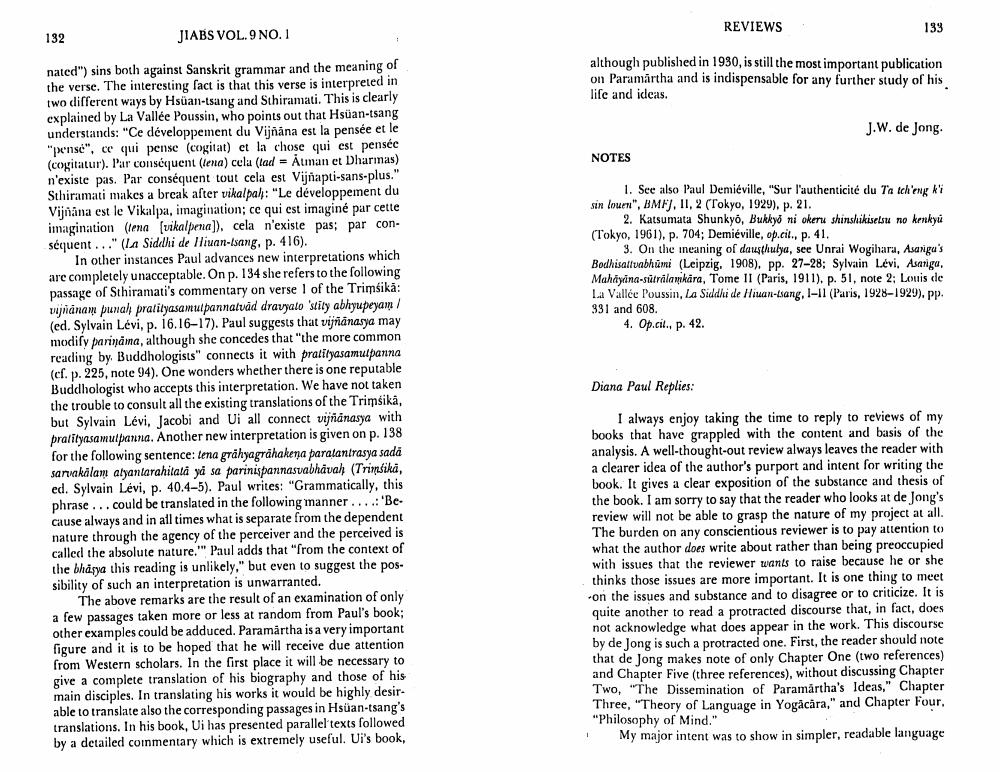________________
132
JIABS VOL. 9 NO.1
REVIEWS
133
although published in 1930, is still the most important publication on Paramartha and is indispensable for any further study of his life and ideas.
J.W. de Jong
NOTES
1. See also Paul Demiéville, "Sur l'authenticité du Ta tch'ng ki sin louen", BMFJ, II, 2 (Tokyo, 1929), p. 21.
2. Katsumata Shunkyo, Bukkyd ni okeru skinshikisetsu no krnkyu (Tokyo, 1961), p. 704; Demiéville, op.cit., p. 41.
3. On the ineaning of dausthulya, see Unrai Wogihara, Asangu's Bodhisallabhumi (Leipzig, 1908), pp. 27-28; Sylvain Levi, Asariga, Mahiyana-sütrálawikara, Tome II (Paris, 1911), p. 51, note 2: Louis de La Vallée Poussin, La Siddhi de Huan-lsang, 1-11 (Paris, 1928-1929). pp. 331 and 608
4. Op.cit., p. 42.
Diana Paul Replies:
nated") sins both against Sanskrit grammar and the meaning of the verse. The interesting fact is that this verse is interpreted in two different ways by Hsuan-sang and Sthiramati. This is clearly explained by La Vallée Poussin, who points out that Hsuan-tsang understands: "Ce développement du Vijnana est la pensée et le "pense", ce qui pense (cogitat) et la chose qui est pensée (cogitatur). Par conséquent (lena) celu (tad - Auman et Dharmas) n'existe pas. Par conséquent tout cela est Vijnapti-sans-plus." Sthiramati makes a break after vikal pah: "Le développement du Vijñāna est le Vikalpa, imagination; ce qui est imaginé par cette imagination (tena (vikalpena]), cela n'existe pas; par conséquent ..." (La Siddhi de Hiuan-lsang, p. 416).
In other instances Paul advances new interpretations which are completely unacceptable. On p. 134 she refers to the following passage of Sthiramati's commentary on verse l of the Trimsika: vijnanam punah pratityasamutpannatad dravyalo stily abhyupeyam/ (ed. Sylvain Lévi, p. 16.16-17). Paul suggests that vijñanasya may modify parinama, although she concedes that "the more common reading by Buddhologists" connects it with pratityasamu panna (cf. p. 225, note 94). One wonders whether there is one reputable Buddhologist who accepts this interpretation. We have not taken the trouble to consult all the existing translations of the Trimsika, but Sylvain Lévi, Jacobi and Ui all connect vijnanasya with pralityasamutpanna. Another new interpretation is given on p. 138 for the following sentence: tena gráhyagrahakena paratantrasya sada sarvakalam alyantarahitata ya sa parinispannasvabhävah (Trimsika, ed. Sylvain Levi, p. 40.4-5). Paul writes: "Grammatically, this phrase ... could be translated in the following manner....: 'Be. cause always and in all times what is separate from the dependent nature through the agency of the perceiver and the perceived is called the absolute nature." Paul adds that "from the context of the bhäsya this reading is unlikely." but even to suggest the possibility of such an interpretation is unwarranted.
The above remarks are the result of an examination of only a few passages taken more or less at random from Paul's book; other examples could be adduced. Paramartha is a very important figure and it is to be hoped that he will receive due attention from Western scholars. In the first place it will be necessary to give a complete translation of his biography and those of his main disciples. In translating his works it would be highly desirable to translate also the corresponding passages in Hsuan-tsang's translations. In his book, Ui has presented parallel texts followed by a detailed coinmentary which is extremely useful. Ui's book,
I always enjoy taking the time to reply to reviews of my books that have grappled with the content and basis of the analysis. A well-thought-out review always leaves the reader with a clearer idea of the author's purport and intent for writing the book. It gives a clear exposition of the substance and thesis of the book. I am sorry to say that the reader who looks at de Jong's review will not be able to grasp the nature of my project at all. The burden on any conscientious reviewer is to pay attention to what the author does write about rather than being preoccupied with issues that the reviewer wants to raise because he or she thinks those issues are more important. It is one thing to meet on the issues and substance and to disagree or to criticize. It is quite another to read a protracted discourse that, in fact, does not acknowledge what does appear in the work. This discourse by de Jong is such a protracted one. First, the reader should note that de Jong makes note of only Chapter One (two references) and Chapter Five (three references), without discussing Chapter Two, "The Dissemination of Paramartha's Ideas," Chapter Three, "Theory of Language in Yogacara," and Chapter Four, "Philosophy of Mind."
My major intent was to show in simpler, readable language




